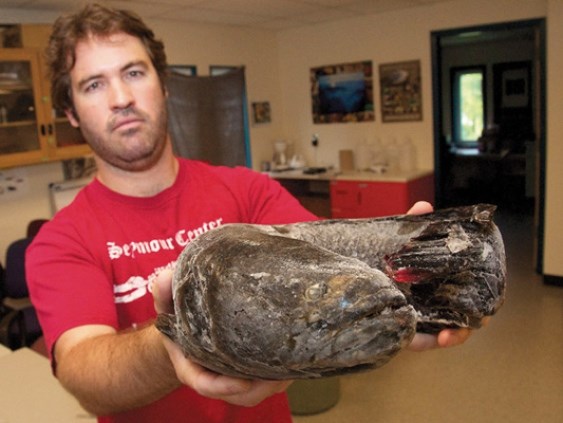The autopsy results are in, and biologists have new information on the infamous snakehead fish that was captured in a Burnaby pond in 2012.
A team of researchers now knows what the fish ate, how long it was in Central Park's pond, and what type of snakehead it was.
"Initially, everybody thought it was a northern snakehead, which has been identified as a threat by Fisheries and Oceans Canada, but in fact, it turned out to be a blotched snakehead after we did our DNA analysis," said Dave Scott, an SFU biology student who worked on the investigation.
As the name implies, the northern snakehead is found in northern climates and can survive in colder waters, while the blotched snakehead is typically found further south. Scott said the blotched snakehead wasn't as much of a risk because it wouldn't be able to tolerate cold conditions, but it's unclear if the snakehead could have survived the winter in Burnaby's Central Park pond.
"We're not actually sure. They are not very well studied," Scott said. "It seemed to be surviving OK."
News of the snakehead in Burnaby's Central Park spread after someone filmed the fish and uploaded the video on YouTube in the summer of 2012. There were widespread concerns the fish would multiply and decimate indigenous species with its voracious appetite. Snakeheads are also known to eat small mammals, and they can wriggle on land and travel from one body of water to another.
Curious onlookers showed up at the pond, hoping to catch or spot the snakehead. The B.C. Environment Ministry sent in a team to drain the lake and catch the snakehead, which was then sent to SFU for analysis. The biologists worked on the fish for a couple of months, sent out samples, waited for results and then wrote up their findings, which will be published in the Management of Biological Invasions Journal, an online scientific journal about invasive species.
The researchers also discovered the snakehead had been in the pond for 33 to 93 days by comparing internal tissues with frozen blotched snakeheads bought from fish markets in Vancouver.
"We know it wasn't born in the pond," Scott said. "Somebody must have released it in the couple of months before it appeared in the YouTube video."
While they couldn't determine the snakehead's sex or age, they did confirm the fish had eaten other non-native species from the pond, including carp, goldfish, minnows, catfish and crayfish. They also found no evidence of eggs in the pond, and considering there was only one snakehead spotted in the pond, it's highly unlikely it had the chance to breed.
SFU biology professor Jonathan Moore said they called it "the Canadian Snakehead Investigation," or CSI for short.
"We got the fish, and we figured we might as well learn as much as we could from it. We used genetics to figure out what species (it was). We used stable isotopes, they are like chemical signatures," Moore said.
"It's interesting because it's just one fish, but at the same time, we can learn about that one fish."
After the snakehead was captured, the provincial government banned possession, transport or breeding of live snakeheads and other invasive species. Snakeheads are eaten for food and even kept in tanks as pets.
"That one fish basically helped changed legislation that regulates invasive species," Moore said.
The snakehead's body is now at the Royal B.C. Museum in Victoria.
"It's missing some chunks, but it's mostly intact," Moore said, chuckling.



